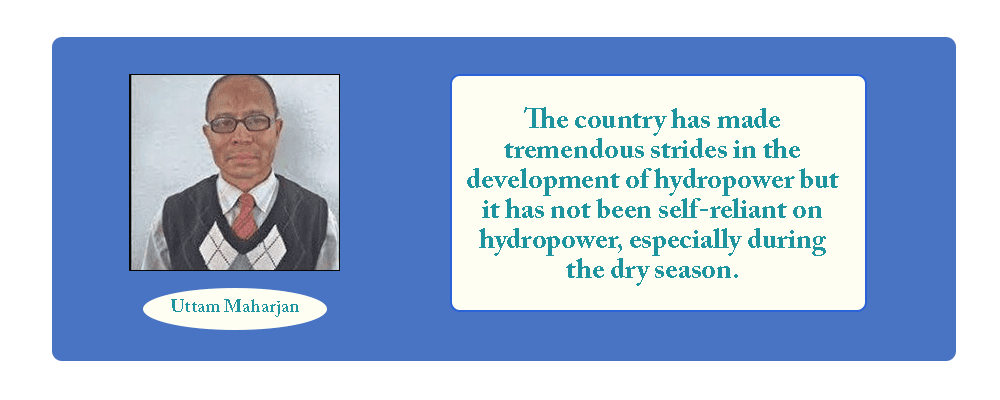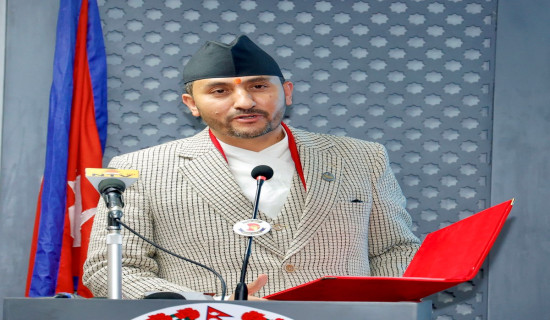- Sunday, 18 January 2026
Headway In Hydropower Development
Hydropower is the most important source of energy in Nepal. Blessed with over 6,000 rivers and rivulets, the country has immense potential for generating electricity by harnessing water resources. The first hydropower plant was installed in Pharping in 1968 BS, when the Rana oligarchy was ruling the country. The plant had a 500 kilowatt capacity. The development of hydropower was going on slowly till the end of the Panchayat system in 2046 BS, when the country had 176 megawatts (MW) of electricity. At that time, the distribution of electricity was confined mostly to the urban areas. And electricity generation was state-controlled.
With political changes in the 1990s and adoption of an open market economy and liberalisation policy, the Electricity Act, 2049 BS made a provision allowing the private sector to generate electricity. This provision did not, however, suffice to encourage the private sector to step into the hydropower sector. Hydropower is a high-stakes field entailing a huge investment. There was no guarantee that the electricity generated by the private sector would be purchased by the government. There was also no system of fixing rates of purchase. Fortunately, the power purchase agreement (PPA) provision was made in 2055 BS, setting the stage for the private sector to sell the electricity generated by them to the government.
Electricity generation
Now, the country generates 2,650 MW of electricity. The Nepal Electricity Authority (NEA) generates 1,139 MW of electricity, while the private sector generates 1,511 MW of electricity. Out of 1,139 MW of electricity, 661 MW of electricity is generated by the projects under the NEA, while 478 MW of electricity is generated by the subsidiary companies of the NEA. Overall, the NEA generates 43 per cent of the electricity, whereas the private sector generates 57 per cent. This shows that the private sector generates more electricity than the NEA does. At present, the 140 MW reservoir-based Tanahun project is being constructed by the NEA. The 635 MW reservoir-based Dudhkoshi project is in process. And a public company has been established for the 1,200 MW Budhigandaki project.
The prospects for hydropower development in the country are bright. Both the NEA and the private sector are moving ahead with executing additional hydropower projects. Projects with a capacity for generating 11,716 MW of electricity are in the pipeline for PPAs. Projects having a capacity for generating 12,000 MW of electricity are awaiting survey licences. Likewise, projects that can generate 29,765 MW of electricity are in the study and construction phases.
The country has made tremendous strides in the development of hydropower but it has not been self-reliant on hydropower, especially during the dry season. At present, the generation of electricity has dropped to 30 per cent, with the private sector generating 14 per cent of the installed capacity. As such, there are power outages in the Morang-Sunsari corridor in Koshi state, affecting the factories operating there. The NEA has clarified that it is forced to resort to undeclared load-shedding as rainfall is scant and snow in the mountains has not melted as desired. Moreover, heat waves in the Terai belt and wildfires have exacerbated the situation.
The NEA is importing 500 MW of electricity from India to recoup the shortfall in power. Even this is not enough. The only means for making the country self-sufficient in electricity and enabling the country to sell surplus power to India, Bangladesh and other countries is through completing the under-construction hydropower projects in time and launching new projects. What is more, constructing transmission lines in sufficient numbers is equally important. Such transmission lines are important in transferring power from one location to the other within the country as well as for the import or export of surplus power from or to neighbouring countries such as India and Bangladesh.
India has allowed the country to sell 364 MW of electricity through the India Energy Exchange Limited. A Joint Vision Statement On Power Sector Cooperation between Nepal and India was unveiled in April 2022. Hydropower projects are reservoir-based or of a run-of-the-river type. For the country, reservoir-based projects are appropriate. Such projects can generate power constantly irrespective of whether it is the dry season or the rainy season. But such projects are costly as compared to run-of-the-river ones. The operation of such projects entails high relocation and compensation costs.
Private investment
In the past, hydropower projects were launched by the government in collaboration with donor agencies such as the World Bank, Asian Development Bank or Japan International Cooperation Agency. The donor agencies would provide grants or soft loans. The government would also make investments in such projects. Political instability, opposition to foreign donor-funded hydropower projects by some political groups and environmental groups and such other factors would hamper the desired development of the hydropower sector. Now, the situation has changed. Opposition to hydropower projects is rarely heard nowadays.
The hydropower sector can contribute greatly to the economy of the country. There are many private-sector companies working in this sector. The Nepal Rastra Bank has also categorised the hydropower sector among the productive sectors. Banks and financial institutions are encouraged to invest in the hydropower sector. The private sector has demanded that they should be allowed to trade in power in both internal and external markets. The government should address their demand, if deemed reasonable. After all, the government and the private sector should work synergistically to fully harness the potential of hydropower.
(Maharjan has been regularly writing on contemporary issues for this daily since 2000.)












-original-thumb.jpg)




